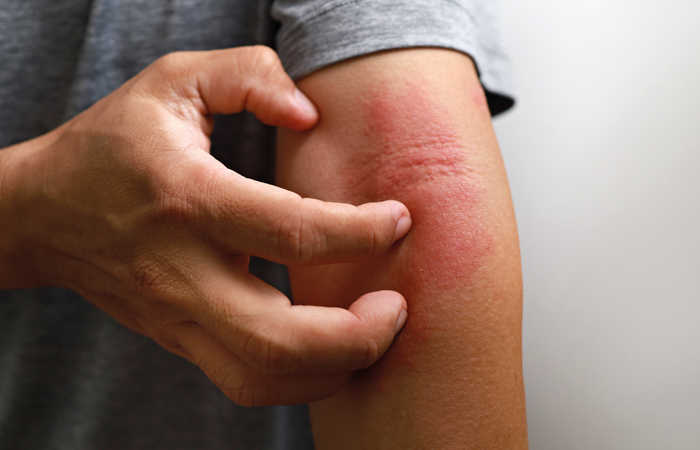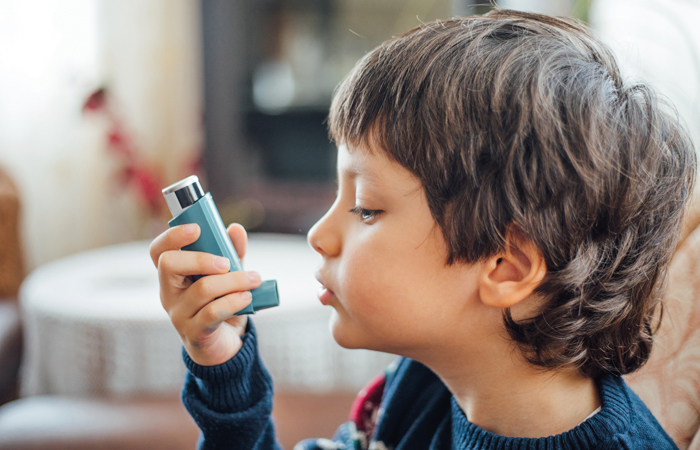In Conditions
Follow this topic
Bookmark
Record learning outcomes
An allergy is the body’s immune system’s response to substances such as pollens, foods, and house dust mites which, in most people, cause no problems. However, for others, their immune systems identifies these ‘allergens’ as a threat and produces an inappropriate response. These reactions can range from mild – such as localised itching – to anaphylaxis in more severe cases, which can lead to upper respiratory obstruction and collapse and can be fatal.
Allergic responses
When an allergen enters the body, it triggers an antibody response, with cells releasing substances such as histamine which cause swelling, inflammation and itching of the surrounding tissues.
Allergic reactions usually happen within a few minutes of exposure to an allergen, with common symptoms of an allergic reaction including:
- Sneezing, wheezing, coughing and shortness of breath
- Sinus pain or runny nose
- Hives
- Swelling
- Itchy eyes, ears, lips, throat and mouth
- Sickness, vomiting and diarrhoea.
Common allergens
Allergies are very common, with charity Allergy UK estimating they affect more than one in four people in the UK at some point in their lives. They’re particularly prevalent in children, and while some allergies go away as a child gets older, many are lifelong. The most common causes of allergic reactions are airborne allergens – namely pollen, dust, pet dander and mould spores. “Pollen is found in the air we breathe inside and especially outside, in dust, on our clothes, hair, bodies and pet fur,” explains Max Wiseberg, airborne allergens expert and creator of HayMax organic drug-free allergen barrier balms. “Dust mite allergens can usually be found all around our houses, in our beds and in offices and any other buildings. Pet dander can be found in dust and in our pet’s fur. And mould can be found in bathrooms, basements, kitchens and attics and mould spores from fungi can be found in the air we breathe outside, too.”
Common symptoms of an allergy to airborne allergens include sneezing, a runny nose, itchy and watery or streaming eyes, nasal congestion and a general clogged up feeling in the nose and throat. Thankfully, pharmacy teams can step in to give customers a range of over-the-counter (OTC) and lifestyle advice to deal with airborne allergens.
“With any allergy, prevention is key,” says Max. “An allergen barrier balm applied to the nostrils and bones of the eyes in the morning and throughout the day traps dust allergens before they enter the body, as well as pet allergens, mould and pollen. Antihistamine tablets and capsules can relieve most symptoms – sneezing, itchy, runny eyes, skin irritation, itchy nose and throat – but are less effective for nasal congestion. Antihistamine nasal sprays can quickly ease itching, sneezing and watering but are generally only protection against mild symptoms. And steroid nasal sprays and drops reduce inflammation in the nose, but they work best for clearing nasal symptoms – itching, sneezing, watering and congestion. Sprays sometimes clear eye symptoms too, and eye drops may reduce itchy, watering [and/or] swollen eyes.”
The best way to treat an allergy is to avoid the allergen entirely, but if this is challenging, damp dusting and vacuuming regularly will help. Other tips include avoiding cutting grass or playing or walking in grassy areas; wear glasses instead of contact lenses, and wrap-around style sunglasses; and shower daily to remove pollen particles from the hair and body.
Cow’s milk allergy in babies
Cow’s milk allergy (CMA) occurs when the body’s immune system mistakenly reacts to proteins found in cow’s milk. According to the British Dietetic Association (BDA), CMA affects two to three per cent of babies and young children in the UK, although most grow out of it by the age of five.
Annette Weaver, clinical dietetic advisor at Allergy UK, says symptoms of delayed cow’s milk allergy can manifest in the skin, gut and general wellbeing. “Many of the symptoms (e.g. eczema, reflux, colic, loose stools and constipation) are very common in infants without allergies, so cow’s milk should only be excluded under strong suspicion of an allergy after assessment by a trained health professional. Mild to moderate cases are usually managed in primary care, but children with multiple allergies or more severe symptoms will need to be referred to a specialist doctor. Faltering growth, significant blood or mucous in stools and severe eczema are red flags that can indicate more severe allergy.”
Help with hayfever
Hayfever (allergic rhinitis) is a common allergic reaction to the pollen produced by plants and trees in spring and summer and can affect people in different ways – with symptoms including sneezing and coughing, a runny or blocked nose, itchy, red or watery eyes, and issues in the upper respiratory tract.
Recent research from Allergy UK showed around 49 per cent of people report suffering with hayfever symptoms, and there are a variety of triggers that can make the condition worse.
Increased exposure to airborne irritants such as cigarette smoke can exacerbate hayfever. Stress can also worsen hayfever as it undermines immune function, and anyone who already has sensitive eyes is more likely to react to pollen in the atmosphere, as their eyes are already inflamed and reactive.
Although there is no cure for hayfever, there are some effective medicines and natural products available to relieve its symptoms and those of other airborne allergens. The most common class of medicines used to treat hayfever are antihistamines – in tablet form, but also as eye drops and creams – which block the action of histamine in the body. Sodium cromoglicate is an ingredient found in many allergy eye drops which helps reduce the release of histamine, and antiseptic eye drops can be useful in cases of allergic red, sore eyes. Antihistamine nasal sprays work by blocking the effect of histamine inside the nose, thereby reducing the allergic reaction, while steroid nasal sprays work by fighting inflammation and mucus production.
Many customers prefer natural or drug-free options to tackle allergy symptoms such as allergen barrier balms, air filters and air purifiers, acupressure hayfever bands, nasal filters and natural antihistamines such as quercetin and butterbur, available in capsules and tablets. “There are lots of different ways to help, and remedies work in several different ways, so can be taken individually or in combination to help combat the symptoms,” says Max.
Skin allergens
The most common skin allergens include soaps and detergents, perfumes, disinfectants and several plants. “Cosmetic ingredients such as preservatives, fragrances and hair dye can all lead to blotchy breakouts on the skin,” says George Sandhu, deputy pharmacy superintendent at Well. “Rubber, including latex, can be a common allergen.”
The main symptoms of a skin allergy may vary, but can include a runny nose or sneezing, pain or tenderness in the face. “Some patients might present with a cough or wheezing and in some severe cases breathlessness can occur,” says George. “Itchy skin or raised rashes on the skin might also be a symptom of an allergy, whilst swollen eyes and a sick feeling are also known symptoms. Some patients will present with skin that is cracked, filled with fluid and has a stinging sensation.”
There are a number of treatments which can be given to patients, including emollients and steroid creams if suitable, but George stresses that “patients should always speak to their pharmacist first”.

Encourage customers to avoid scratching rashes as this may result in an infection or exacerbate the rash.
“49 per cent of people report suffering with hayfever symptoms”
Medication allergens
Medication allergies vary widely amongst individuals but some of the most common varieties include penicillin and other beta-lactam antibiotics; nonsteroidal anti-inflammatory drugs (NSAIDs); sulfonamides which are used for a wide range of conditions such as antibiotics, diabetes, inflammation and high blood pressure; anticonvulsants; chemotherapy drugs; local anaesthetics; and insulin.
Because of their position, community pharmacy teams play a crucial role in advising patients about medication allergies and helping prevent an allergy occurring.
“It’s important to ensure that all known allergies are documented in the patient’s records and regularly update records with any new allergy information,” says Kenny Chan, lead information services pharmacist at Numark. “Teams can also educate patients on the importance of informing all healthcare providers about their allergies, as well as informing patients on how to recognise symptoms of an allergy such as hives, itching, swelling, difficulty breathing, and anaphylaxis. With new prescriptions, discuss any potential allergic reactions and if there is a known allergy, look at potential alternatives and always raise concerns with the prescriber to find a more suitable alternative. Also advise patients to check the ingredients of OTC medications for potential allergens.”
For mild reactions to medicines “an antihistamine may help with symptoms and reduce the reaction,” says Kenny, but teams should “advise patients with severe allergies to carry an adrenaline auto-injector” and ensure they know how to use it. “Encourage patients to have an emergency plan in place and to inform family and friends about their allergies,” he adds, “and follow up with patients who have experienced an allergic reaction to ensure they are managing their condition effectively, and encourage patients to report any adverse reactions to their pharmacy”.
The scale of allergies
Since allergy symptoms can vary from being inconvenient to potentially fatal, pharmacy teams should also know what to do – and how to advise patients with allergy – about the scale of allergic reactions.
People should always have antihistamines, and if prescribed, a blue reliever inhaler and/or adrenaline auto injector (EpiPen) available. Mild to moderate symptoms can be treated with an antihistamine, and mild wheeziness with a blue reliever inhaler such as Salbutamol (Ventolin) or Terbutaline (Bricanyl).
More severe symptoms such as swelling of the tongue or throat associated with difficulty in breathing, difficulty talking or hoarse voice, faintness or dizziness, looking very pale or blue and clammy, being disorientated or unresponsive, or collapse indicate an anaphylactic reaction, which needs to be treated immediately with epinephrine (adrenaline) and a call to 999 to ask for an ambulance with a paramedic crew stating that it is a severe allergic reaction.
Armed with the right knowledge, pharmacy staff are in the ideal situation to help customers understand all kinds of allergies and better manage their symptoms so they can get the right treatment earlier – and maybe even save their life.
Common food allergens
While it is possible to be allergic to almost any type of food, there are a small number of foods that cause the majority of food allergies.
According to Margaret Kelman, head of clinical services at Allergy UK, the most common food allergies include “cow’s milk (dairy), egg, fish, peanut, sesame, tree nuts such as almonds, soy, wheat, and seafood (molluscs and crustaceans). Other emerging food allergies that are becoming more prevalent include those to legumes such as peas and lentils, kiwi fruit, coconut, strawberries and banana”.
Mild to moderate symptoms of allergy usually present within minutes of eating the food, are not life threatening, and can include swelling to the lips, eyes or face, itchy rash (hives) and redness to the skin, abdominal pain, nausea and/or vomiting, and an itchy/tingling mouth.
However, Margaret stresses that anaphylaxis – the most severe type of allergic reaction – “should always be treated as a medical emergency, requiring immediate treatment with adrenaline and ongoing monitoring in a hospital setting”. Signs of anaphylaxis include swelling of the tongue or throat, difficulty/noisy breathing, wheezing or persistent cough, hoarse voice or cry in babies, dizziness or collapse, and young children can appear pale and floppy.
Once again, there are a number of ways pharmacy staff can support people with food allergies, including giving advice on age-appropriate treatment choices such as oral solution antihistamines versus tablet form, and being able to identify the person responsible within the pharmacy who can explain and/or demonstrate to the patient how to use allergy medication and devices like adrenaline auto-injectors.
Margaret says it’s also vital to “be aware that medication and treatments can contain food allergens such as peanut oil/arachis oil or soya, and advise the individual to seek guidance from a healthcare professional [like a] GP or nurse if they are concerned they or their child may have a food allergy”.

Pharmacy teams should ensure customers prescribed with an inhaler know how to use it correctly.

